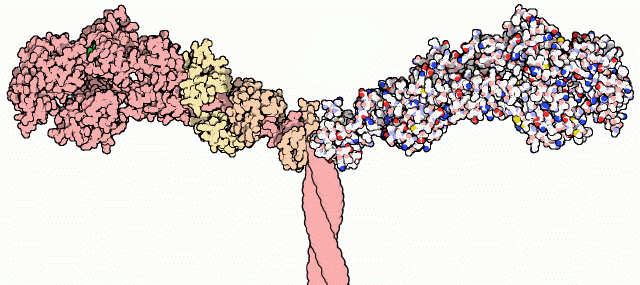|
Inhaltsübersicht | Nanomaschinen | Moleküle | Programme | Kurse | Fun | Links |
||
| > |
Myosin

Molecular Motion
All of the different movements that you are making right now--your fingers on the computer keys, the scanning of your eyes across the screen, the isometric contraction of muscles in your back and abdomen that allow you to sit comfortably--are powered by myosin. Myosin is a molecule-sized muscle that uses chemical energy to perform a deliberate motion. Myosin captures a molecule of ATP, the molecule used to transfer energy in cells, and breaks it, using the energy to perform a "power stroke." For all of your voluntary motions, when you flex your biceps or blink your eyes, and for all of your involuntary motions, each time your heart beats, myosin is providing the power.Sprinting with Myosin
Myosin requires huge amounts of ATP when muscles are exerted. When you start running, the supply of ATP in your muscles lasts only about a second. Then, the muscle cells shift to phosphocreatine, a backup source of energy, which can be converted quickly into about 10 seconds worth of ATP. Then, if you are still running full tilt, your muscles start using glycogen, a molecule that stores glucose. This lasts for a minute or two, building up toxic acids as the sugar is used up. Then, the sprint is over and you have pushed your muscles to the limit. If, however, you slow down and pace yourself, your muscles can perform much longer. The blood vessels will dilate and your heart rate will increase, bringing twenty times as much blood through the muscles. Your muscle cells can then use this extra oxygen to produce far more ATP from the sugar in glycogen. Instead of collapsing after a short sprint, you now have the resources for a mountain hike or a marathon.Anatomy of a Molecular Muscle
Myosin is composed of several protein chains: two large "heavy" chains and four small "light" chains. The structures available in the PDB, such as the one shown above, contain only part of the myosin molecule. In the illustration above, from PDB entry 1b7t, atoms in the heavy chain are colored red on the left-hand side, and atoms in the light chains are colored orange and yellow. The whole molecule is much larger, as shown on the next page, with a long tail that has been clipped off to allow the molecule to be studied. Fortunately, the crystal structures include most of the "motor" domain, the part of the molecule that performs the power stroke, so we can look at this process in detail.Next: Power in Numbers
Last changed by: A.Honegger,